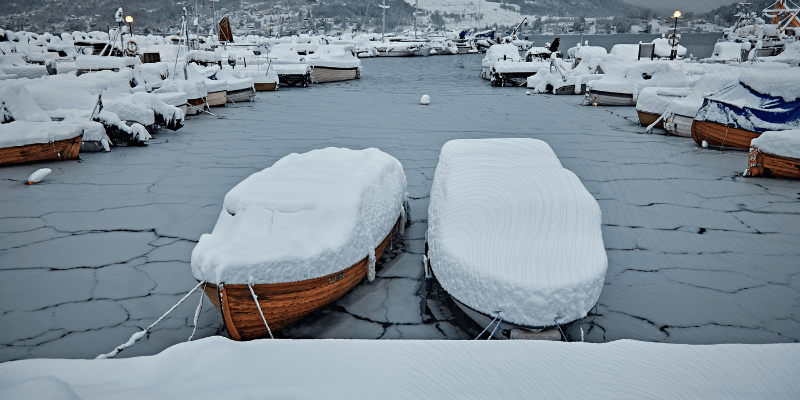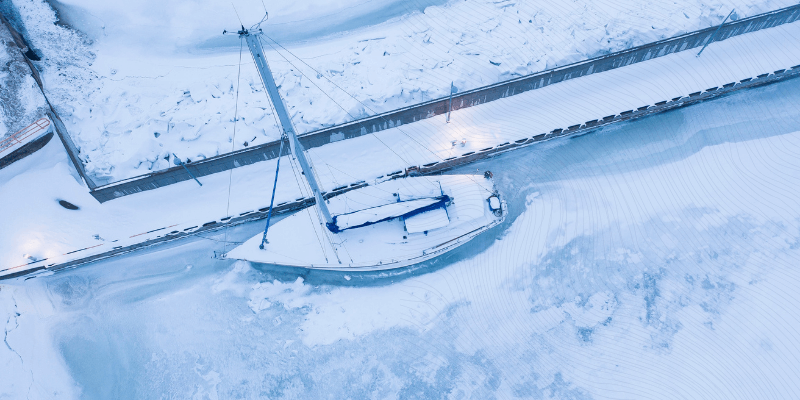As the colder winter months begin to set in, it’s time for you to start thinking about how to winterise your boat and get her ready to brave the season. This is particularly important if you’re going to be leaving her moored up, but if you’re going to continue using her throughout the winter months, it’s still good to give her a check over anyway.

Maintaining your boat both internally and externally will keep your boat looking at its best, while also extending the life of the boat’s engine and other parts. It’s important to winterise your boat in order to minimise any damage over the cold months.
Dark spots of mould can be caused by lack of ventilation, and they can be extremely difficult to scrub off, diesel bugs can cause fuel lines to block and your engine to fail while batteries can also be destroyed by cold weather – so it’s best that you put in the time to ensure your boat is ready for winter, before you end up having to put more time, money and effort in later when you come to use her in the warmer months.
Winterising your boat can seem like a daunting task if you’ve never done it before, so we’ve put together this blog post to go through all the steps that’ll help you achieve it successfully.
Remove Items
Before storage, you must ensure that you remove and clear out your boat as much as you can. Items such as cushions and soft furnishings are vulnerable to damp, so are best kept away at home.
If you wish to keep these items on board your boat, then it’s best to keep them propped up so that air can circulate properly.
It’s also best to take home any valuable items, particularly if your boat is staying moored up for winter.
How to Winterise Your Boat: Store Your Boat in Winter
The best place to store your boat throughout those cold winter months is undercover and out of the water in a storage area. However, this can be a costly process and it is not always an option available to everyone. Another alternative is to cover your boat with a shrink-wrap or tarpaulin.
Keeping your boat out of the water can reduce the risk of weather damage – if you are thinking about keeping your boat on dry land, then it’s a good idea to think about winterising your boat a little earlier as the lower temperatures affect them sooner as water retains heat longer than air.
Ventilate & Deshumidify Your Boat
If you’re leaving your boat moored up without power throughout the winter months, it’s best that you keep air circulating throughout your vessel rather than keeping everything closed off – obviously without allowing too much rainwater in the boat. A lack of air flowing through your boat will only lead to mould and mildew.
As previously mentioned, mould is extremely difficult to scrub off, but not only does it look and smell unpleasant, it can cause allergic reactions along with respiratory problems.
Tools to help with moisture:
- Moisture absorber or trap
- Dehumidifier
Moisture absorbers or traps are a cheaper alternative to a dehumidifier – and if you’re storing/mooring your boat for winter without power, you won’t have the ability to keep a dehumidifier plugged in.
However, if you do have access to power, you can keep all your boats hatches sealed and install a dehumidifier and small heater. If possible, it’s then best to keep your dehumidifier on a countertop on a continuous drain mode with a hose running off into the sink.
How to Winterwise Your Boat: Drain Water From the Boats’ System
When preparing your boat for winter, you should remove any water from its system. Remove water from bilges and empty your tanks.
If you have a flexible water tank, it can be removed and taken home to be cleaned, or you can fill it with a sterilising fluid and leave to soak before draining off, giving your tank a thorough clean out before leaving them over the winter.
If you are leaving your boat out on the water, it’s best to ensure that your seacocks are firmly closed so they don’t leak out, however, if your boat is going to be ashore throughout the winter, they should be left open.
Protect Your Boat From the Elements
Regardless of whether your boat will spend the winter months on the water or ashore, you’ll need to protect her from the elements as best as possible.
Ensure that you use a good fitted cover over the cockpit if possible, removing items such as sprayhoods, dodgers, sail covers and sails. However, if you are planning on leaving a furling headsail on during the winter, ensure that it’s secured and tied up so it can’t become free and cause potential damage.
You may be opting to leave your boat moored throughout the winter, if doing so, make sure you double up your boat’s lines so there’s extra security if one fails. Carry out a thorough check for any leaks and make sure you have a float-switch operated bilge pump in case any water gets in.
 How to Winterise Your Boat: Prepare Your Engine for Winter
How to Winterise Your Boat: Prepare Your Engine for Winter
The most basic steps to winterising your boats engine is to change the oils and filters, filling up your fuel to the maximum level and adding in anti-bug additive, then flushing out the raw-water cooling system.
If your boat has a closed-circuit cooling system, then it should be topped up with anti-freeze while Vaseline can also be smeared on the fuel filler cap thread in order to prevent any rainwater getting inside the fuel tank.
Other Tasks to Consider to Winterise Your Boat
- Check electrics
- Removing lights
- Washing & storing lines
- Check insurance cover
Remember, the hours that you spend winterising your boat making sure that everything is properly stored and cared for when it’s not going to be in use over the colder months will inevitably save you time and money further down the line when you start using your boat again in the warmer months.
